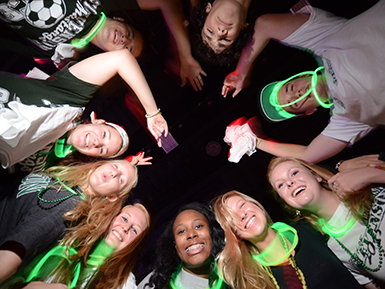
[This post is the second installment of a four-part guest author series by English senior Amber Deter, in which she reports on her experience researching and writing in Iceland in Summer 2019. The first part is here. Above photo: Glymur waterfall. Photo by Jordan Hundelt. Used with permission.]
“So, who’s going first?”
Our Research Director, Kyle, stood over a small pool of water. Bubbles rose up to the surface, indicating this was a natural spring. Rauðamelsölkelda was our fourth hike of the day, and all of us were soaked to the bone. It had rained continuously throughout the day, switching from a drizzling mist to a drenching pour and everything in-between. We had heard of a natural carbonated spring and after getting lost for a few minutes (but finding a gorgeous waterfall), we had finally found it. Or at least, we were pretty sure we had found it.
All twelve of us stood unsure around the pool, shuffling our feet. No one wanted to be the first after being warned about where to drink from. If you see sheep, the rule is no, and there were three watching us from the hilltop.
“I’ll do it,” I said with a shrug of the shoulders. I was here, in Iceland, with an opportunity to drink from a natural carbonated spring.
Of course I was going to take it.
[Photo: Drinking from the carbonated spring. Photo by Jordan Hundelt. Used with permission.]
This was only one of many hikes the team went on during our week’s stay. All of them had incredible views and climbs. Only some had my topic of interest: mythology. One of my favorite places was Rauðfeldsgjá Gorge, or Rauðfeldar Canyon. There is a short ten minute hike up to the narrow opening of the canyon. You can climb inside using the stream’s rocks as stepping stones and enter into a small open area leading to the waterfall inside. It’s a cozy little place with rocks covered in Iceland’s vibrant green moss. This gorge is part of the Saga trails, places where events are said to have happened in Iceland’s famous Sagas. If you want a good read, I highly recommend checking those out.
However, one of the most interesting myths was the story behind the name of Glymur, a waterfall named the tallest in Iceland until around 2007 when Morsárfoss glacier started melting. Below is an excerpt from my writing for the publication on how Glymur obtained its name. Similar to many Icelandic myths, mischievous elves or “Huldufolk” are not to be crossed. After a man goes back on a promise made to an Elfish woman, he learns that there are consequences:
The woman pointed at the man and said, “I cast a spell on you that you shall become the worst of the whales in the sea!” Immediately, the man went mad and ran off, jumping into the sea from a cliff as he transformed into a large whale. He was named Redhead because he had worn a red cap, which turned the head of the whale red. As he was cursed to do, Redhead wreaked havoc, drowning ships and men alike. He took refuge in the fjord between Kjalarnes and Akranes, now known as Hvalfjörður (Whale Fjord).
One day, Redhead sank a ship and killed two sons of a pastor living in Saubær. The man was old and blind but known to have supernatural abilities. Upon learning of his sons’ deaths, the pastor asked his daughter to lead him down to the fjord. There he placed his cane in the water, and the whale appeared. The pastor’s daughter guided him up the shore to the mouth of the river Botnsá and noticed that the whale swam alongside them as if being led. As they climbed the mountainside the whale struggled as the river was small and he was large. When he started to climb the waterfall, everything shook and trembled, creating a thunderous rumbling as big as an earthquake. This is the origin of the name of the waterfall, Glymur (Roaring), and the hills above are called Skjálfandahæðir (Shaking Hills).
The pastor continued on until he reached the lake the river flows from. Redhead, upon reaching the lake, was so exhausted he exploded. Since this day, the lake has been called Hvalvatn (Whale Lake) and a hill nearby is named Hvalfell (Whale Hill). Whale bones have been found in and around the lake, possibly proving the tale is true.
Iceland is full of breath-taking views and adventurous hikes, and folklore is everywhere. If you see an oddly shaped rock, there’s most likely an interesting tale of a troll turned to stone by the sun.
Tune in next week for more of Amber’s experiences of Icelandic culture, including visiting Reykjavik and Borgarnes, conversing with locals, and seeing a one-man show by a local artist.





